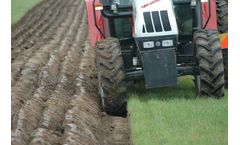Soil Redistribution By Intense Tillage Articles & Analysis
19 articles found
Soil compaction is becoming a major issue worldwide. Not only in the Netherlands but globally the soil is deteriorating very badly. Soil compaction is a form of soil degradation, in which the soil structure is lost because the soil is compressed. This global problem is still underestimated and causes problems for agriculture, nature, and climate. Furthermore, soil compaction leads to loss of ...
With a lot of noise currently surrounding sustainability in British agriculture, there are many conflicting viewpoints on the best approach farmers should take to care for their environment. In this blog, we discuss conservation agriculture, and how by looking after your soil, you’re looking after your bottom line. We explore how it can benefit farmers to increase yields and lower crop ...
2020 has been a challenging year with forces so far out of our control, it actually seems the situation has gone from the ridiculous to the absurd. With saturated land, the New Agriculture Bill (the bill) and the Coronavirus pandemic the industry has to look at improving farming practices to stay on track. The main conversation is how farmers cover the ground with less passes, less disturbance ...
About a month ago the US Army Corps of Engineers (Corps), The US Environmental Protection Agency (EPA) and the US Department of Agriculture (USDA) issued a memorandum of understanding about issues relating to implementing section 404 of the Clean Water Act (CWA) and the Food Security Act (FSA). The concern is the fact the the USDA and the EPA/Corps define wetlands differently. In short, the ...
In most of the US, this fall was a wet one. Chances are, you didn’t get much of a chance to get fall anhydrous in the ground. Beacuse of this, we wanted our agronomist, Barry Anderson, to answer a few of our burning questions related to fall nitrogen application. You may have missed the window this year, but here are some tips to keep in mind for next year. 1. At what rate/ ...
In Hungary, the MARGINS project is being conducted near Lake Balaton - the largest lake in Central Europe. The lake is renowned for its beauty and wildlife. Its surrounding hilly landscape is covered with rich brown forest soil. This landscape is, however, prone to soil erosion -in particular, rills develop when soil is weakened by excessive tillage and exposed to intense rainstorms. If not ...
BySyngenta
Received for publication December 19, 2008. Cereal production that now sustains a world population of more than 6.5 billion has tripled during the past 40 yr, concurrent with an increase from 12 to 104 Tg yr–1 of synthetic N applied largely in ammoniacal fertilizers. These fertilizers have been managed as a cost-effective form of insurance against low yields, without regard to the inherent effect ...
Nitrogen mineralization occurring near the soil surface of agroecosystems determines the quantity of plant-available N, and soil enzymes produced by microorganisms play significant roles in the N mineralization process. Tillage systems may influence soil microbial communities and N mineralization enzymes through alterations in total soil C and N. Soil aggregates of different sizes provide diverse ...
Novel management practices are needed to improve the declining dryland crop yields and soil organic matter contents using conventional farming practices in the northern Great Plains. We evaluated the 21-yr effect of tillage and cropping sequence on dryland grain and biomass (stems + leaves) yields of spring wheat (Triticum aestivum L.), barley (Hordeum vulgare L.), and pea (Pisum sativum L.) and ...
In dry land areas of the Mediterranean region, farmers' decisions are particularly difficult due to irregular rainfall. Yield risk, soil erosion and desertification are important problems. Decision-making behaviour of farmers is supposed to incorporate a particular concern in the adoption of strategies to decrease income variability, to conserve soil and to guarantee a comfortable level of ...
Compacted soils have been found in intensively cultivated vegetable crop regions of Central Wisconsin, resulting in the wide scale use of subsoil tillage by growers. The goal of this project was to assess potato (Solanum tuberosum L.) yield and quality response to soil compaction and subsoil tillage. Potato quality factors evaluated were marketable yield, tuber size distribution, internal ...
Continuous no-till (NT) results in soil improvements, primarily in the surface 5 cm of soil. One-time tillage may improve NT systems by inverting surface soil with less improved deeper soil. Research was conducted to determine the change in abundance of soil microbial groups after a one-time tillage of NT and their recovery dynamics. Experiments were conducted under rainfed corn (Zea mays L.) or ...
Little is known about soil redistribution by tillage and its impact on the properties of soil profiles with thin soil layers on hillslopes. ...
No tillage often delays soil warming and drying, thus sowing too early in the spring may compromise seed viability due to prolonged exposure to cold and wet soil in the northern Corn Belt. Coating seed with a temperature-activated polymer may circumvent the adverse effects of exposing seeds to cold and wet soil. Germination and emergence of noncoated and polymer-coated corn (Zea mays L.) and ...
Tillage systems may affect soil C sequestration, with a potential impact on crop productivity or organic matter mineralization. We evaluated crop yield, C inputs to the soil, and in situ CO2–C fluxes under no-till and conventional tillage (disk tillage) during the 3- to 6-yr period from the installation of an experiment in an Entic Haplustoll of the Semiarid Pampean Region of Argentina to ...
Pulses including faba bean (Vicia faba L.), lentil (Lens culinaris Medic.), and field pea (Pisum sativum L.) are important components of the cropping systems of semiarid high-altitude northern Ethiopia. Yield potential is often constrained by severe water deficits during grain fill which might be alleviated by reducing runoff throughout the season using microbasin or tie-ridge tillage. Research ...
Under water-limited conditions, increasing water use efficiency (WUE) is essential for successful crop production. A 7-yr study (1977–1982, and 1985) to evaluate tillage and tillage timing effects on soil water storage, crop water use, and grain yield of winter wheat (Triticum aestivum L.) and spring green pea (Pisum sativum L.) in rotation, was conducted near Pendleton, OR. Treatments included ...
Conservation tillage is a commonly adopted best management practice for reducing runoff and erosion, and increasing infiltration. Yet current methodologies in place to monitor conservation tillage adoption are largely inappropriate for regional or national assessments. A major goal of this study was to evaluate the spectral response properties of four alternative winter cover crops using remotely ...
A number of policy tools are used to reduce soil erosion from agricultural lands in the USA, including education and technical assistance, financial assistance, land retirement, and conservation compliance requirements. Education and technical assistance by public and private sources can be effective in promoting the adoption of conservation tillage by farmers for whom that practice will be ...








